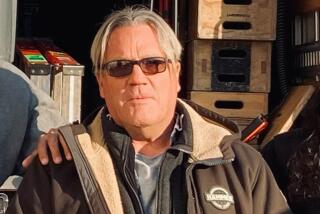Is it safety first -- or last?
PRODUCER Terence Chang said it was the wind that caused the horrific fatal fire on the set of John Woo’s latest epic, “Red Cliff.” The production, Asia’s most expensive movie ever, was re-creating a major battle from 3rd century China on the outskirts of Beijing last month. Small ships, set ablaze, were purposely torpedoed into a group of large warships that had been chained together.
“It was an outdoor shoot, and the wind was so strong, the fire began blowing in the direction of the stuntmen, who were stationed on a larger ship getting rammed by a fireboat,” says Chang, who has produced dozens of films, including “Mission Impossible 2” and “Face/Off.” A 23-year-old stuntman was burned to death. Three other stuntmen were burned but will recover. Two more hurt their legs when they jumped off the stunt ship into the water to escape. “It was horrible, truly horrible,” Chang says.
“Red Cliff” isn’t the only would-be blockbuster beset by accidents and tragedy. Two stuntmen were burned while making the Adam Sandler comedy “You Don’t Mess With the Zohan.” Visual effects technician Conway Wickliffe was killed while prepping the Batmobile for the upcoming “The Dark Knight.” According to a production source, Wickliffe and a colleague were videotaping the Batmobile as it spun around a racetrack to see if it was properly rigged to do stunts. Wickliffe was hanging out the window with the video recorder when the driver accidentally careened into a tree. The police investigated and found no wrongdoing.
A Bond curse?
And then there is the upcoming James Bond film, “Quantum of Solace,” which has been so riddled with accidents big and small that the English papers have begun talking of “The Bond Curse.” An Aston Martin delivery person did manage to drive the $190,000 car into Italy’s Lake Garda (he survived; the car didn’t).
Yet the far more serious accident -- and the one that actually was the responsibility of the film production -- took place along the twisty, narrow road around the lake, when the Bond team attempted to film “Solace’s” spectacular opening sequence.
According to London’s Sunday Times, the scene consisted of two Alfa-Romeos chasing Bond’s Aston Martin. One of the Alfas gets stuck behind a slow-moving truck, tries to overtake the vehicle and slams into an oncoming truck -- at 100 mph.
There was no driver in the second Alfa, intended for the collision. It was attached to the truck it was supposed to be overtaking, creating the illusion that it had drawn level with it. As the oncoming truck approached, the driver of the carrier truck released the driverless Alfa by detonating explosive charges.
Unfortunately, instead of simply crumpling underneath the wheels of the oncoming truck, the driverless Alfa was catapulted into the air by the force of the collision. It flew across the road and smashed into the first Alfa, carrying stuntmen Aris Comninos and Bruno Verdirosi. Their car veered off course and smashed through the guard wall on the side of the road; half the car hung over a 50-foot drop, the other half wedged against a wall. Verdirosi managed to get out, but Comninos, in his racing harness, was trapped inside. Some crew members sat at the edge of the car to prevent it from toppling over, while others managed to get Comninos out.
Comninos was flown to a hospital in Verona and, according to two sources, is now walking around.
Technology a boon
Anecdotally, it sounds like a lot of accidents, but almost everyone involved in safety issues in Hollywood says that in fact sets have gotten much safer over the last five to 10 years, primarily because of technological advances. For instance, because of computer graphics, stunt people can freely wear wires during highflying scenes -- which are just erased by computer afterward. It’s hard for audiences to tell exactly how Spider-Man swings through tall buildings or Bourne survives brutal car crashes; these heroes just do, courtesy the magic of high-tech moviemaking.
“In the last 10 years, and particularly in the last five years, CGI has kept the risk assessment down on most stunts,” says Sony’s president of physical production, Gary Martin. “We have alternatives. We have safe ways to plan the stunts and keep people out of harm’s way.”
Sony, like all studios, has a team of safety specialists who travel from set to set to monitor stunts and crew safety. Martin declines to speak specifically about any Sony film -- such as “Quantum of Solace” -- but he says the recent spate of accidents is mostly a reflection of the increased amount of films with stunts and spectacle.
Indeed, one only has to look at the summer lineup from “Iron Man” to “Hancock” to notice the amount of stunts and special effects that have been performed. “It’s a function of how many films are made. I also believe that nobody ever hears when the stunt goes [well]. And 99% of the stunts go well,” Martin says.
According to the last statistics available (for the year 2006), the U.S. Bureau of Labor Statistics reports five occupational fatalities (four because of transportation accidents) in the motion-picture business.
Injuries are even harder to calculate. The government reports 1,190 occupational injuries in the motion picture industry for 2006. There were 270 actor injuries. Stunt performers are listed in another category, which includes circus performers and magicians; the group sustained 230 injuries in 2006.
Still, these statistics present only part of the picture because the U.S. government doesn’t calculate deaths or injuries that happen outside the United States, such as those on Bond or Batman.
Stunt people say many injuries are never made public, mostly because they themselves don’t want to hurt their own reputations and possibly stymie further employment.
Preventive efforts
Even those who don’t work directly for studios agree with much of what Martin says. For instance, Kent Jorgensen, the chairman of the International Alliance of Theatrical Stage Employees’ safety committee, says: “It seems like it’s getting safer. Because of the awareness of safety and corporatization of the industry, there’s a lot more emphasis on safety. The employers have instituted training. They have created better communications. They’re providing industrial prevention programs.”
Jorgenson dates the steady improvement to a tragic accident 13 years ago, when a grip fell from the rafters and died during the making of “Indian in the Cupboard.”
This said, he points out it’s much easier for the Occupational Safety and Health Administration to institute safety regulations for set construction than for stunts, which can be inherently dangerous. “OSHA has a hard time covering stunts because of what they’re doing,” says Jorgensen. “It’s like trying to cover a circus act. How do you do a rule for jumping off a building into an air bag? They base it on the professionalism of the people. They’re trusting the professionalism of the people to be an adequate form of doing things safely.”
Howard Keyes, the president of Local 767, Motion Picture Studio First Aid Employees, says there are gaps in the system.
“The studios have safety departments that are very proactive,” says Keyes. “They’re making sure the safety guidelines are followed, whereas independent producers, they don’t have somebody looking over their shoulders to speak of. They try to cut corners where they can. Safety is one of the things they try to get away with. Sometimes they don’t have the proper equipment to make things perfectly safe. On a tight budget, they’re in a hurry to do something.”
Even if stunts are safer these days, it’s probably impossible to totally eradicate injuries, the inevitable accidents that come with trying to satisfy an audience’s appetite for heart-stopping thrills. Common sense says that if you push the envelope, you increase the peril as well. “Everything has a risk,” says IATSE’s Jorgenson. “You try to minimize the risk.”
--
More to Read
Only good movies
Get the Indie Focus newsletter, Mark Olsen's weekly guide to the world of cinema.
You may occasionally receive promotional content from the Los Angeles Times.










